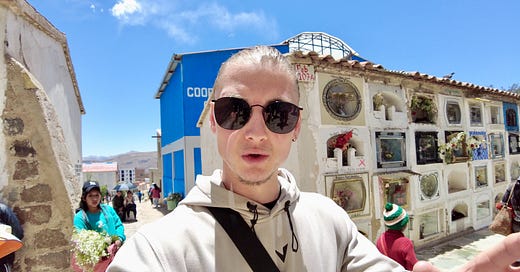The Deadliest City Of Bolivia Celebrates Day Of The Dead Festival 🇧🇴
Bolivia’s Day of the Dead, or Día de los Muertos, is a celebration that offers unique insight into the country’s blend of indigenous and colonial heritage, and I recently had the opportunity to experience it up close in Potosí—a city known for its beauty, resilience, and haunting history. Potosí’s story is unlike any other; once one of the world’s wealthiest cities, it rose to prominence in the 1500s, when the discovery of silver in Cerro Rico drew countless miners and transformed it into the jewel of the Spanish Empire. But beneath this prosperity lay hardship and loss, creating a cultural tapestry that continues to influence life and tradition here today.
A City Built on Silver and Sacrifice
In the heart of Potosí, you can almost feel history in the air. During its peak in the 16th century, it’s said that enough silver was mined here to build two bridges from Bolivia to Madrid and back. Standing in the main plaza, you’re surrounded by architecture and remnants of colonial grandeur, but also by the stories of the miners whose labor fueled this wealth at great personal cost. With Potosí’s mining legacy comes a darker association: it’s one of Bolivia’s deadliest cities, and even today, the dangers of Cerro Rico’s mines loom large over the city’s identity.
Celebrating Día de los Muertos in Potosí
On Bolivia’s Day of the Dead, Potosí’s bustling energy shifts as families gather to honor and remember their loved ones. This celebration has a unique approach; here, it’s about connection rather than mourning. I joined locals at the city’s cemetery, where families set up colorful altars, known as ofrendas, with offerings of the deceased’s favorite foods, drinks, and personal mementos. Each grave becomes a personalized tribute, mixing indigenous Bolivian customs with the influence of Spanish Catholicism.
The smells, sounds, and sights were captivating—from the traditional pastries like tantawawas (bread dolls made in the likeness of the deceased) to the vibrant orange marigolds adorning graves. I sampled some local treats too, including api morado, a warming spiced drink made from purple corn, and salteñas, Bolivia’s beloved meat-filled pastries. Both were offerings meant to welcome the spirits of loved ones and were also shared freely among visitors, reflecting the deep hospitality of Bolivian culture.
Embracing the Depth of Bolivian Tradition
For anyone visiting Bolivia, experiencing the Day of the Dead in Potosí is essential to understanding the country’s cultural depth and resilience. This city isn’t just defined by its silver mines or deadly history—it’s also about community, remembrance, and a unique take on life and death.
My journey through Bolivia’s most famous mining town left me with a profound respect for the people of Potosí and their way of embracing both hardship and celebration. Through the lenses of history, food, and cultural ritual, I gained insight into a side of Bolivia that’s as rich as its past and as resilient as the city itself.
If you’re interested in travel, culture, or history, don’t miss the full story in my video, where I take you deeper into the heart of Bolivia’s fascinating Day of the Dead festival in Potosí.





